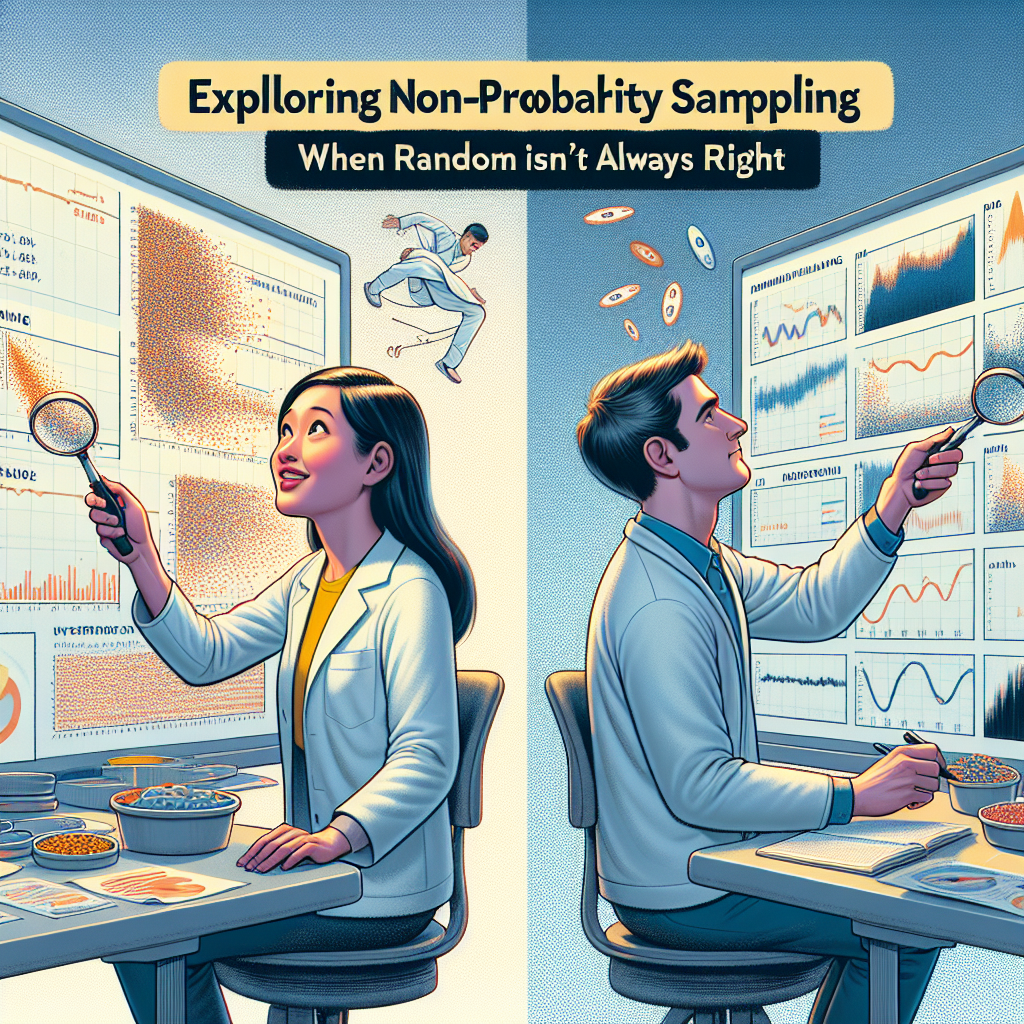
Introduction
In a world increasingly driven by data, the methods we choose for collecting that data can shape decisions in profound ways. One such method, non-probability sampling, challenges the age-old assumption that randomness is the gold standard in research. Whether in marketing, social sciences, or public health, knowing when to step away from random sampling can be the difference between actionable insights and misleading conclusions. In this article, we delve deep into the intricacies of exploring non-probability sampling: when random isn’t always right.
Understanding Non-Probability Sampling
Before fully diving into the nuances, it’s imperative to clarify what non-probability sampling entails. Unlike probability sampling, where every member of a population has an equal chance of being selected, non-probability sampling allows for a more subjective selection process. This means researchers might choose participants based on certain criteria, availability, or even convenience.
Types of Non-Probability Sampling
-
Convenience Sampling: This involves selecting individuals who are easiest to reach. While it may lead to quick data collection, the results may not represent the broader population.
-
Judgmental Sampling: Researchers use their expertise to select subjects based on specific characteristics. This can be particularly useful in qualitative research.
-
Snowball Sampling: Common in social networks, this method relies on existing participants to recruit new ones. This is effective for reaching niche populations.
- Quota Sampling: Researchers establish quotas for various sub-groups within a population and select participants until the quotas are met.
Understanding these types expands our toolbox as researchers and practitioners. By assessing when and how to utilize these methods, we can gain insights that may be unattainable through randomness alone.
When is Non-Probability Sampling the Right Choice?
Real-World Case Study: Marketing Insights
A prominent case comes from a leading beverage company that aimed to launch a new energy drink. Rather than engaging in extensive random sampling, they opted for convenience sampling, focusing on local gyms and fitness centers. By directly interacting with potential consumers who were aligned with their product, they obtained critical insights into flavor preferences and branding elements.
Analysis: This targeted approach enabled them to refine their product offerings prior to a full-scale launch, ultimately resulting in higher initial sales.
Advantages of Non-Probability Sampling
-
Cost-Effective: Non-probability sampling often requires fewer resources, making it accessible for small businesses or startups with limited budgets.
-
Time Efficiency: With pre-determined criteria or accessible populations, researchers can gather data rapidly compared to extensive random sampling methods.
- Targeted Insights: When specific characteristics are essential for the study, selecting participants based on these traits ensures the findings will be relevant and actionable.
Limitations of Non-Probability Sampling
Despite its many advantages, exploring non-probability sampling: when random isn’t always right, doesn’t absolve it of pitfalls. Bias is a primary concern; the subjective nature of participant selection can lead to skewed results. Researchers must remain vigilant, employing strategies to mitigate these biases.
Navigating the Biases: Strategies for Success
-
Triangulation: Utilize multiple methods to validate findings. For instance, corroborating non-probability sampling results with data from probability samples can strengthen conclusions.
-
Transparency: Clearly stating the methods used provides context and allows for a more honest interpretation of findings.
- Reflective Practice: Regularly reviewing why certain participants were chosen over others can help mitigate bias in future studies.
Case Studies Highlighting Non-Probability Sampling
Case Study 1: Public Health Research
A healthcare organization wanted to understand the perceptions of a new health initiative among specific demographics. They utilized judgmental sampling to select individuals who had actively engaged with their services.
Analysis
This approach provided valuable qualitative insights that informed targeted health communication strategies. The feedback from selected participants helped tailor messages that resonated with various community segments.
Case Study 2: Product Development in Technology
A tech startup aimed to test a beta version of their app. By employing snowball sampling within tech enthusiast communities, they gained feedback directly from users who were genuinely invested in the product.
Analysis
The participant-driven recruitment process ensured that feedback came from someone with the potential to be an advocate for the app, leading to valuable suggestions for enhancements and better user engagement strategies.
Non-Probability Sampling in an Age of Data Overload
In today’s data-rich environment, organizations are tasked with filtering noise to extract meaningful insights. Here, exploring non-probability sampling: when random isn’t always right becomes particularly relevant. For instance, during times of crisis—like the COVID-19 pandemic—those who fit specific profiles may have unique experiences that random sampling would overlook.
Impacts on Policy Making
Governments and organizations can utilize non-probability sampling to quickly gather public sentiment on health policies. Using targeted approaches allows for timely feedback that can directly shape policy decisions.
Interactive Elements
To enhance readability and comprehension, consider the following table overview:
| Sampling Method | Description | Use Case |
|---|---|---|
| Convenience Sampling | Selecting easily accessible participants | Quick surveys in malls |
| Judgmental Sampling | Using expert judgment for selection | Academic studies requiring specific knowledge |
| Snowball Sampling | Existing subjects recruit new ones | Niche social networks |
| Quota Sampling | Ensuring representation of sub-groups | Marketing strategies for diverse demographics |
The Role of Technology in Non-Probability Sampling
With advancements in technology, reaching underrepresented groups has become less challenging. Platforms designed for targeted outreach allow researchers to utilize non-probability sampling effectively. Social media, online forums, and professional networks provide avenues to connect directly with desired demographics.
Conclusion
As we explore non-probability sampling: when random isn’t always right, it’s essential to recognize the potential for this method to yield invaluable insights. While random sampling has its place, non-probability methods often offer a more nuanced understanding of complex populations. By embracing these techniques, researchers and practitioners can foster a more robust understanding of the phenomena they study.
FAQs
1. What are the main advantages of non-probability sampling?
Non-probability sampling is cost-effective, time-efficient, and provides targeted insights that can enhance qualitative research efforts.
2. Are there any downsides to using non-probability sampling?
Yes, the primary downside is potential bias due to the subjective selection of participants, which could lead to unrepresentative findings.
3. When should I use non-probability sampling?
Non-probability sampling is particularly useful when you need quick insights, when resources are limited, or when you seek to understand specific sub-groups.
4. Can non-probability sampling still offer valid results?
Absolutely, but it’s crucial to employ strategies such as triangulation and transparency to ensure the findings remain credible.
5. How can I mitigate bias in non-probability sampling?
You can mitigate bias through careful participant selection, using multiple methods to validate findings, and being transparent about the selection criteria.
Final Thoughts
Non-probability sampling offers a powerful alternative to traditional methods, especially in today’s fast-paced, information-rich world. Embrace it with an understanding of its strengths and limitations, and you might just find the insights you were searching for all along.
















